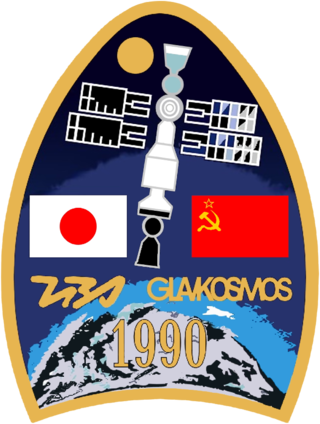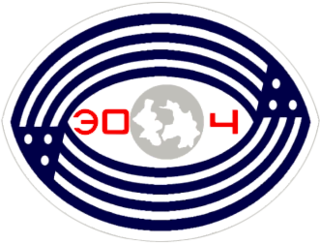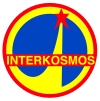
Mir was a space station that operated in low Earth orbit from 1986 to 2001, operated by the Soviet Union and later by Russia. Mir was the first modular space station and was assembled in orbit from 1986 to 1996. It had a greater mass than any previous spacecraft. At the time it was the largest artificial satellite in orbit, succeeded by the International Space Station (ISS) after Mir's orbit decayed. The station served as a microgravity research laboratory in which crews conducted experiments in biology, human biology, physics, astronomy, meteorology, and spacecraft systems with a goal of developing technologies required for permanent occupation of space.

Soyuz is a series of spacecraft which has been in service since the 1960s, having made more than 140 flights. It was designed for the Soviet space program by the Korolev Design Bureau. The Soyuz succeeded the Voskhod spacecraft and was originally built as part of the Soviet crewed lunar programs. It is launched on a Soyuz rocket from the Baikonur Cosmodrome in Kazakhstan. Between the 2011 retirement of the Space Shuttle and the 2020 demo flight of SpaceX Crew Dragon, the Soyuz served as the only means to ferry crew to or from the International Space Station, for which it remains heavily used. Although China did launch crewed Shenzhou flights during this time, none of them docked with the ISS.

Yuri Pavlovich Gidzenko is a Russian cosmonaut. He was a test cosmonaut of the Yuri Gagarin Cosmonaut Training Center (TsPK). Gidzenko has flown into space three times and has lived on board the Mir and the International Space Station. He has also conducted two career spacewalks. Although he retired on July 15, 2001, he continued his employment by a special contract until Soyuz TM-34 concluded. Since 2004 to May 2009, Gidzenko was the Director of the 3rd department within the TsPK. Since May 2009 he serves as the Deputy Chief of Cosmonaut Training Center TsPK.

Vladimir Georgiyevich Titov is a retired Russian Air Force Colonel and former cosmonaut. He has participated in four spaceflight missions. The catastrophic explosion of a Soyuz rocket in 1983 led to him being one of only four people to use a launch escape system. He is married to Alexandra Kozlova, they have two children.

Soyuz TM-2 was a crewed spaceflight to the Soviet space station Mir, which was uncrewed at the time. TM-2 was launched on February 5, 1987, and it was first crewed spaceflight of the Soyuz-TM spacecraft, and the second crewed spaceflight to Mir. The crew of the long duration expedition, Mir EO-2, who were launched by TM-2 consisted of Soviet cosmonauts Yuri Romanenko and Aleksandr Laveykin.

Soyuz TM-4 was a crewed Soyuz spaceflight to Mir. It was launched on 21 December 1987, and carried the first two crew members of the third long duration expedition, Mir EO-3. These crew members, Vladimir Titov and Musa Manarov, would stay in space for just under 366 days, setting a new spaceflight record. The third astronaut launched by Soyuz TM-4 was Anatoli Levchenko, who returned to Earth about a week later with the remaining crew of Mir EO-2. Levchenko was a prospective pilot for the Soviet Space shuttle Buran. The purpose of his mission, named Mir LII-1, was to familiarize him with spaceflight.

Soyuz TM-8 was a 1989 spaceflight which carried the fifth long duration crew to the Soviet space station Mir. It was part of the Soyuz-TM series of spacecraft, which were the fourth generation of the Soviet Soyuz. Soyuz TM-8 was the eighth crewed spaceflight to Mir, and spent 166 days in orbit.

Soyuz TM-11 was the eleventh expedition to the Russian Space Station Mir, using a Soyuz-TM crew transport vessel. The mission notably carried a Japanese television reporter from Tokyo Broadcasting System.

Soyuz TM-21 was a crewed Soyuz spaceflight to Mir. The mission launched from Baikonur Cosmodrome, atop a Soyuz-U2 carrier rocket, at 06:11:34 UTC on March 14, 1995. The flight marked the first time thirteen humans were flying in space simultaneously, with three aboard the Soyuz, three aboard Mir and seven aboard Space Shuttle Endeavour, flying STS-67.

Soyuz TM-22 was a Soyuz spaceflight to the Soviet space station Mir. It launched from Baikonur Cosmodrome Launch Pad 1 on September 3, 1995. After two days of free flight, the crew docked with Mir to become Mir Principal Expedition 20 and Euromir 95. Mir 20 was a harbinger of the multinational missions that would be typical of the International Space Station. After 179 days, 1 hour and 42 minutes on orbit, Reiter obtained the record for spaceflight duration by a Western European.

Soyuz TM-23 was a Soyuz spaceflight which launched on February 21, 1996, to Mir. The spacecraft launched from Baikonur Cosmodrome, and after two days of flight, Yuri Onufrienko and Yury Usachov docked with Mir and became the 21st resident crew of the Station. On September 2, 1996, after 191 days docked with Mir, the ship undocked with the launch crew and Claudie André-Deshays onboard, before eventually landing 107 km (66 mi) south west of Akmola, Kazakhstan.

Soyuz TM-30, also known as Mir EO-28, was a Soyuz mission, the 39th and final human spaceflight to the Mir space station. The crew of the mission was sent by MirCorp, a privately funded company, to reactivate and repair the station. The crew also resupplied the station and boosted the station to an orbit with a low point (perigee) of 360 and a high point (apogee) of 378 kilometers ; the boost in the station's orbit was done by utilizing the engines of the Progress M1-1 and M1-2 spacecraft. At that time a transit between Mir and the International Space Station was already impossible - such a transfer was deemed undesired by NASA - and the orbital plane of ISS had been chosen some time before to be around 120 degrees away from that of Mir. The mission was the first privately funded mission to a space station.

Progress M1-5 was the Progress spacecraft which was launched by Russia in 2001 to deorbit the fifteen-year-old Mir space station in a controlled fashion over a remote ocean area, far away from shipping lanes - otherwise Mir's orbit would have decayed uncontrolled over time, with debris potentially landing in a populated area. The Russian Aviation and Space Agency, Rosaviakosmos, was responsible for the mission.
Progress M-17 was a Russian uncrewed cargo spacecraft which was launched in 1993 to resupply the Mir space station. The thirty-fifth of sixty-four Progress spacecraft to visit Mir, it used the Progress-M 11F615A55 configuration, and had the serial number 217. In addition to delivering cargo, Progress M-17 was also used to demonstrate extended duration Progress missions; remaining in orbit for almost a year with a docked phase lasting 132 days.

Mir EO-4 was the fourth long-duration expedition to the Soviet space station Mir. The expedition began in November 1988, when crew members Commander Aleksandr Volkov and Flight Engineer Sergei Krikalev arrived at the station via the spacecraft Soyuz TM-7. The third crew member of EO-4, Valeri Polyakov, was already aboard Mir, having arrived in August 1988 part way through the previous expedition, Mir EO-3.
Mir EO-5 was the 5th long duration expedition to the space station Mir, which lasted from September 1989 to February 1990. The two person crew was launched and landed in the spacecraft Soyuz TM-8, which remained docked to Mir throughout the mission. The crew are often referred to as the Soyuz TM-8 crew.

Mir EO-2 was the second long duration expedition to the Soviet space station Mir, and it lasted from February to December 1987. The mission was divided into two parts, the division occurring when one of the two crew members, Aleksandr Laveykin, was replaced part way through the mission by Aleksandr Aleksandrov. Laveykin was replaced because ground-based doctors had diagnosed him with minor heart problems.
Mir EP-3 was a week-long crewed spaceflight to the Soviet space station Mir, during the long-duration expedition Mir EO-3. It was the sixth crewed spaceflight to Mir, and was launched with the spacecraft Soyuz TM-6. This spacecraft also carried Valeri Polyakov, who would stay aboard Mir after the crew of EP-3 returned to Earth in Soyuz TM-5. The crew of EP-3, also known as the Soyuz TM-6 crew, consisted of Soviet cosmonaut Vladimir Lyakhov as commander, and the first Afghan to visit space, Abdul Ahad Mohmand.

Mir EO-19 was the nineteenth crewed expedition to the space station Mir, lasting from June to September 1995. The crew, consisting of Russian cosmonauts Anatoly Solovyev and Nikolai Budarin, launched on June 27, 1995 aboard the Space Shuttle Atlantis on the STS-71 mission. After remaining aboard Mir for approximately 75 days, Solovyev and Budarin returned aboard the Soyuz TM-21 spacecraft on September 11, 1995.

Mir EO-8 was the eighth crewed expedition to the space station Mir, lasting from December 1990 to May 1991. The crew, consisting of Russian cosmonauts Viktor Afanasyev and Musa Manarov, launched along with space journalist Toyohiro Akiyama on December 2, 1990 aboard Soyuz TM-11. Akiyama returned aboard Soyuz TM-10 with the outgoing Mir EO-7 crew on December 10. Afanasyev and Manarov returned aboard Soyuz TM-11 on May 26, 1991.

















